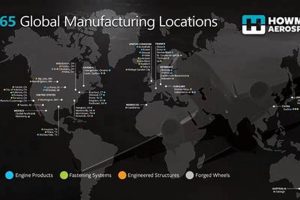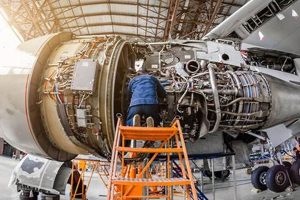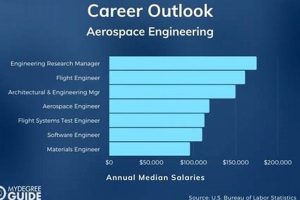The sector encompasses the design, development, manufacturing, testing, and maintenance of aircraft, spacecraft, and associated components. Activities within this field extend from theoretical research and engineering to the practical application of scientific and technological advancements in flight. This field also involves national defense, space exploration, and commercial air transportation.
Its significance lies in its role as a driver of technological innovation, spurring advancements in materials science, propulsion systems, electronics, and automation. This innovation translates into economic growth through job creation, export revenue, and the development of related industries. Historically, the field’s development has been intertwined with national security and international competition, leading to substantial government investment and rapid technological progress.
The following discussion will delve into the critical aspects of this dynamic sector, including the current state of the commercial aviation sub-sector, ongoing innovations in spacecraft technologies, and the role of regulatory frameworks in shaping future developments, and environmental challenges.
Entering or operating within the aerospace field requires careful consideration of several critical factors to ensure success and sustainability.
Tip 1: Prioritize Research and Development Investment: Sustained innovation is paramount. Allocate significant resources to research into new technologies, materials, and manufacturing processes to maintain a competitive edge.
Tip 2: Emphasize Safety and Reliability: Stringent quality control measures are non-negotiable. Adhere to rigorous testing protocols and safety standards to minimize risks and ensure operational integrity.
Tip 3: Foster Strategic Partnerships: Collaboration with other industry players, research institutions, and government agencies can provide access to specialized expertise, shared resources, and new market opportunities.
Tip 4: Adapt to Evolving Regulatory Landscapes: Stay abreast of changes in aviation regulations, environmental standards, and trade policies. Compliance is essential for avoiding penalties and maintaining operational licenses.
Tip 5: Cultivate a Highly Skilled Workforce: Invest in training programs and educational initiatives to develop a workforce proficient in advanced engineering, manufacturing, and software development skills.
Tip 6: Address Environmental Sustainability: Implement strategies to reduce carbon emissions, minimize noise pollution, and develop environmentally friendly technologies, such as sustainable aviation fuels and electric propulsion systems.
Tip 7: Embrace Digital Transformation: Leverage data analytics, artificial intelligence, and automation to optimize operations, improve efficiency, and enhance decision-making across all aspects of the sector.
Adherence to these guidelines is crucial for navigating the challenges and capitalizing on the opportunities within this sophisticated sector. A focus on innovation, safety, collaboration, and sustainability is essential for achieving long-term success.
The subsequent sections will explore emerging trends and future prospects within the sector, offering insights into the evolving landscape of aerospace technologies and applications.
1. Innovation
Innovation is a central driver of progress within the aerospace field, fundamentally shaping its capabilities and competitiveness. New technological advancements directly impact the design, performance, and safety of aircraft and spacecraft. This correlation stems from the need to overcome inherent challenges associated with flight and space exploration, such as increasing fuel efficiency, reducing drag, enhancing structural integrity, and developing more efficient propulsion systems. For example, the ongoing development of composite materials has enabled the creation of lighter, stronger airframes, resulting in significant fuel savings and increased payload capacity.
The significance of innovation extends beyond incremental improvements to existing technologies; it also encompasses the development of entirely new approaches to flight and space travel. The rise of electric propulsion systems, for instance, represents a paradigm shift in aircraft design, offering the potential for quieter, more sustainable air travel. Furthermore, advances in automation and artificial intelligence are transforming aircraft manufacturing processes, reducing costs and improving efficiency. These examples highlight the practical applications of innovation, demonstrating its impact on both the economic and operational aspects of the field.
In summary, innovation serves as the engine for advancement within the aerospace field, driving advancements in performance, efficiency, and safety. The continuous pursuit of new technologies is essential for maintaining a competitive edge and addressing the evolving challenges of air and space travel. Ongoing investment in research and development, coupled with a willingness to embrace disruptive technologies, is critical for sustaining future progress and ensuring the continued viability of the field.
2. Regulation
The aerospace industry is fundamentally shaped by a comprehensive framework of regulations, impacting every facet of its operations, from design and manufacturing to maintenance and air traffic control. These regulations, enacted by national and international bodies, serve to ensure safety, security, and environmental protection, forming a crucial component of the sector’s operational integrity. Failure to comply with established standards can result in significant penalties, including fines, grounding of aircraft, and reputational damage, thus underscoring the critical need for strict adherence. For instance, the European Union Aviation Safety Agency (EASA) and the Federal Aviation Administration (FAA) in the United States set rigorous standards for aircraft certification, mandating specific design features, testing protocols, and maintenance schedules.
These regulatory frameworks extend beyond aircraft operations to encompass broader industry practices. Environmental regulations, such as those aimed at reducing noise pollution and greenhouse gas emissions, influence the development of new aircraft technologies and operational procedures. Security regulations, including those related to passenger screening and cargo handling, are implemented to mitigate the risk of terrorism and other security threats. Air traffic control systems, governed by international standards, are designed to ensure the safe and efficient flow of air traffic, minimizing the risk of collisions and delays. The interconnected nature of these regulatory elements highlights the complexity of managing this global sector.
In conclusion, regulation is not merely an external constraint on the aerospace industry but an intrinsic element that shapes its evolution and ensures its safety and sustainability. The ongoing adaptation to evolving regulatory landscapes, coupled with a commitment to compliance, is essential for navigating the challenges and realizing the opportunities within this dynamic and globally interconnected sector. While these regulations can present operational and financial challenges, they ultimately safeguard the public and support the long-term viability of the sector.
3. Manufacturing
Manufacturing forms the bedrock of the aerospace field, serving as the tangible realization of theoretical designs and engineering specifications. Without advanced manufacturing processes, the development of innovative aircraft and spacecraft would remain purely conceptual. The sector’s manufacturing component is characterized by precision engineering, the use of advanced materials, and adherence to stringent quality control standards. The relationship between manufacturing and the broader aerospace industry is causal: improvements in manufacturing techniques directly result in more efficient, safer, and more capable aircraft. For example, the development of automated fiber placement (AFP) technology has revolutionized the production of composite aircraft structures, enabling faster production rates and improved structural integrity compared to traditional hand lay-up methods. This enhanced manufacturing capability has directly facilitated the widespread adoption of composite materials in modern aircraft designs, such as the Boeing 787 Dreamliner and the Airbus A350 XWB.
The practical significance of understanding the interplay between manufacturing and the aerospace field extends to various areas. It informs strategic decisions regarding investment in new technologies, workforce development, and supply chain management. For instance, the increasing use of additive manufacturing (3D printing) in the aerospace sector presents both opportunities and challenges. While additive manufacturing enables the production of complex geometries and customized parts, it also requires significant investment in specialized equipment and skilled personnel. Moreover, the integration of additive manufacturing into established supply chains necessitates careful consideration of material properties, quality control procedures, and regulatory compliance. The shift to advanced manufacturing methods requires a skilled workforce capable of operating and maintaining sophisticated equipment, highlighting the need for training and educational programs tailored to the demands of the modern aerospace sector.
In conclusion, manufacturing is not merely a supporting function within the aerospace field; it is an integral and enabling force that drives innovation and shapes the industry’s capabilities. The sector’s continued progress depends on the ongoing development and adoption of advanced manufacturing technologies, coupled with strategic investments in workforce development and supply chain optimization. Navigating the challenges associated with advanced manufacturing, such as high capital costs and complex regulatory requirements, is crucial for maintaining a competitive edge and ensuring the long-term viability of the aerospace sector. Continuous improvements in manufacturing processes are fundamental to enhancing the safety, efficiency, and sustainability of air and space travel.
4. Sustainability
The pursuit of sustainability has become an increasingly critical imperative for the aerospace industry, driven by growing environmental concerns and societal expectations. As a sector historically reliant on fossil fuels and with a significant carbon footprint, the transition towards more sustainable practices is essential for ensuring its long-term viability and minimizing its environmental impact.
- Alternative Fuels
The development and adoption of sustainable aviation fuels (SAF) are pivotal in reducing the industry’s reliance on conventional jet fuel. SAF, derived from sources like biomass, algae, or waste products, offer the potential to significantly decrease carbon emissions throughout the fuel lifecycle. Real-world examples include airlines partnering with fuel producers to test and implement SAF blends in commercial flights. The widespread adoption of SAF faces challenges such as cost competitiveness and scalability of production.
- Aircraft Design and Technology
Aircraft manufacturers are actively pursuing innovations in aircraft design and technology to enhance fuel efficiency and reduce emissions. This includes the development of more aerodynamic airframes, advanced engine technologies, and the integration of lightweight materials like composites. Hybrid-electric and fully electric propulsion systems represent a longer-term goal, offering the prospect of zero-emission flight for shorter routes. These design changes contribute to significant operational efficiency improvements.
- Operational Efficiency
Airlines and air navigation service providers are implementing operational strategies to minimize fuel consumption and emissions. These strategies include optimizing flight routes, reducing aircraft weight, implementing more efficient air traffic management procedures, and utilizing single-engine taxiing when possible. The collaborative efforts of airlines and air traffic control authorities are essential to maximize the environmental benefits of these operational improvements. Real-world impact is demonstrated through fuel savings recorded by implementing these initiatives.
- Carbon Offsetting and Reduction Schemes
Carbon offsetting programs and industry-wide carbon reduction schemes like the Carbon Offsetting and Reduction Scheme for International Aviation (CORSIA) provide mechanisms for mitigating the environmental impact of air travel. CORSIA aims to stabilize international aviation emissions at 2020 levels through a combination of carbon offsetting and emissions reduction measures. Airlines invest in carbon reduction projects, such as reforestation or renewable energy initiatives, to offset their emissions. It represents an initial step towards mitigating the environmental impact of international aviation.
These multifaceted approaches underscore the industry’s commitment to addressing its environmental footprint. While challenges remain in achieving complete sustainability, the ongoing development and implementation of these strategies represent significant progress towards minimizing the environmental impact of air travel. The integration of sustainable practices is crucial for ensuring the long-term viability and responsible operation of the aerospace industry.
5. Global Competition
Global competition is a defining characteristic of the aerospace industry, influencing technological advancements, market dynamics, and strategic decision-making across the sector. The pursuit of market share, innovation, and cost efficiency among international players shapes the industry’s trajectory and impacts its long-term sustainability.
- Innovation Race
The competitive landscape fosters an innovation race, where companies continuously strive to develop cutting-edge technologies to gain a competitive advantage. This includes advancements in aircraft design, propulsion systems, materials science, and software development. For example, Airbus and Boeing, as primary competitors in the commercial aviation sector, consistently invest heavily in research and development to introduce more fuel-efficient aircraft with enhanced capabilities. The implications of this competition are seen in the rapid pace of technological evolution within the industry.
- Supply Chain Dynamics
Global competition impacts supply chain dynamics, forcing aerospace manufacturers to optimize their sourcing strategies to reduce costs and improve efficiency. Companies seek to leverage international suppliers who can provide high-quality components at competitive prices. This can lead to complex global supply chains, as evidenced by the extensive international partnerships involved in the production of aircraft like the Boeing 787, which sources parts from numerous countries. These complex supply chains present challenges related to logistics, quality control, and geopolitical risks.
- Market Access and Trade Agreements
Access to international markets is critical for aerospace companies, and global competition influences trade negotiations and regulatory frameworks. Governments often support their domestic aerospace industries through subsidies, export financing, and trade agreements. For example, disputes between the United States and the European Union over subsidies to Boeing and Airbus have highlighted the importance of fair trade practices in the sector. The outcomes of these negotiations directly affect market access and competitiveness for aerospace firms.
- Emerging Markets
The rise of emerging markets, particularly in Asia, presents both opportunities and challenges for established aerospace companies. These markets represent significant growth potential for aircraft sales, maintenance services, and other aerospace-related activities. However, they also foster the emergence of new competitors, such as COMAC in China, which are seeking to capture a share of the global aerospace market. Established companies must adapt their strategies to compete effectively in these evolving markets.
These facets of global competition underscore its pervasive influence on the aerospace industry. The constant pressure to innovate, optimize supply chains, secure market access, and adapt to emerging markets shapes the strategic decisions of companies and governments alike. Understanding these dynamics is crucial for navigating the complexities of the global aerospace landscape and achieving long-term success in the sector. The aerospace industry’s ongoing evolution is inextricably linked to the forces of global competition.
6. Skilled Workforce
The aerospace industry’s foundation rests upon the availability of a highly skilled workforce. The design, manufacturing, maintenance, and operation of aircraft and spacecraft necessitate specialized knowledge and expertise across various disciplines. A deficit in qualified personnel directly impedes innovation, compromises safety standards, and weakens the sector’s competitiveness. For example, the development of advanced composite materials for aircraft structures requires engineers with expertise in materials science, manufacturing processes, and structural analysis. Similarly, the increasing complexity of avionics systems demands technicians proficient in electronics, software development, and system integration. The absence of such skilled personnel limits the industry’s capacity to develop and implement new technologies.
Investment in education and training programs is essential to cultivating a workforce capable of meeting the industry’s evolving demands. Partnerships between aerospace companies and educational institutions, such as universities and vocational schools, facilitate the transfer of knowledge and skills. These collaborations can involve curriculum development, research collaborations, and internships, ensuring that graduates possess the technical expertise and practical experience necessary to contribute effectively to the industry. Furthermore, ongoing professional development is crucial for maintaining the competence of the existing workforce in the face of technological advancements and regulatory changes. Failure to prioritize workforce development can result in skills gaps, increased labor costs, and a decline in overall productivity.
In conclusion, a skilled workforce is not merely a desirable attribute but a fundamental prerequisite for the success and sustainability of the aerospace industry. Prioritizing education, training, and professional development is crucial for ensuring that the industry possesses the talent necessary to drive innovation, maintain safety standards, and compete effectively in the global marketplace. Addressing the challenges associated with workforce development requires a collaborative effort involving aerospace companies, educational institutions, and government agencies, all working together to cultivate a pipeline of skilled professionals capable of meeting the industry’s future needs.
Frequently Asked Questions
The following addresses common inquiries regarding the aerospace industry, providing concise and informative answers to enhance understanding of this complex field.
Question 1: What are the primary sectors within the aerospace industry?
The industry comprises commercial aviation (manufacturing and operation of passenger and cargo aircraft), military aerospace (development and production of military aircraft, defense systems, and related technologies), and space exploration (development of spacecraft, satellites, and launch vehicles).
Question 2: How does regulation impact the aerospace industry?
Regulation shapes virtually every aspect of aerospace operations, from aircraft design and manufacturing to air traffic control and environmental standards. Compliance with regulatory requirements is critical for ensuring safety, security, and operational efficiency.
Question 3: What are the key drivers of innovation in the aerospace industry?
Innovation is driven by the need to enhance fuel efficiency, improve aircraft performance, reduce emissions, and increase safety. Key areas of innovation include advanced materials, propulsion systems, avionics, and automation technologies.
Question 4: What role does sustainability play in the aerospace industry?
Sustainability is an increasingly important consideration, with efforts focused on reducing carbon emissions, minimizing noise pollution, and developing environmentally friendly technologies, such as sustainable aviation fuels and electric propulsion systems.
Question 5: What are the primary challenges facing the aerospace industry?
The industry faces challenges related to rising fuel costs, increasing regulatory burdens, global competition, workforce shortages, and the need to adapt to evolving technological landscapes.
Question 6: How does global competition affect the aerospace industry?
Global competition influences technological advancements, market dynamics, and strategic decision-making across the sector. Companies strive to gain a competitive advantage through innovation, cost efficiency, and access to international markets.
Understanding these fundamental aspects is crucial for comprehending the dynamics and complexities of this critical global sector.
The subsequent section will present a concise summary of the points presented, synthesizing key insights for enhanced understanding.
In Summary
This exploration of the aerospace industry has illuminated its multifaceted nature. The sector’s defining elements relentless innovation, stringent regulation, advanced manufacturing processes, the imperative of sustainability, intense global competition, and the critical role of a skilled workforce collectively shape its trajectory and impact on the global landscape. These interdependent forces dictate the sector’s ability to advance technologically, operate safely, and contribute responsibly to the global economy.
Continued engagement with the complexities of this dynamic field is essential for informed decision-making and strategic planning within both public and private sectors. A sustained commitment to innovation, coupled with a proactive approach to evolving challenges, is crucial to ensure the aerospace industry remains a driver of progress and a vital contributor to global prosperity.







